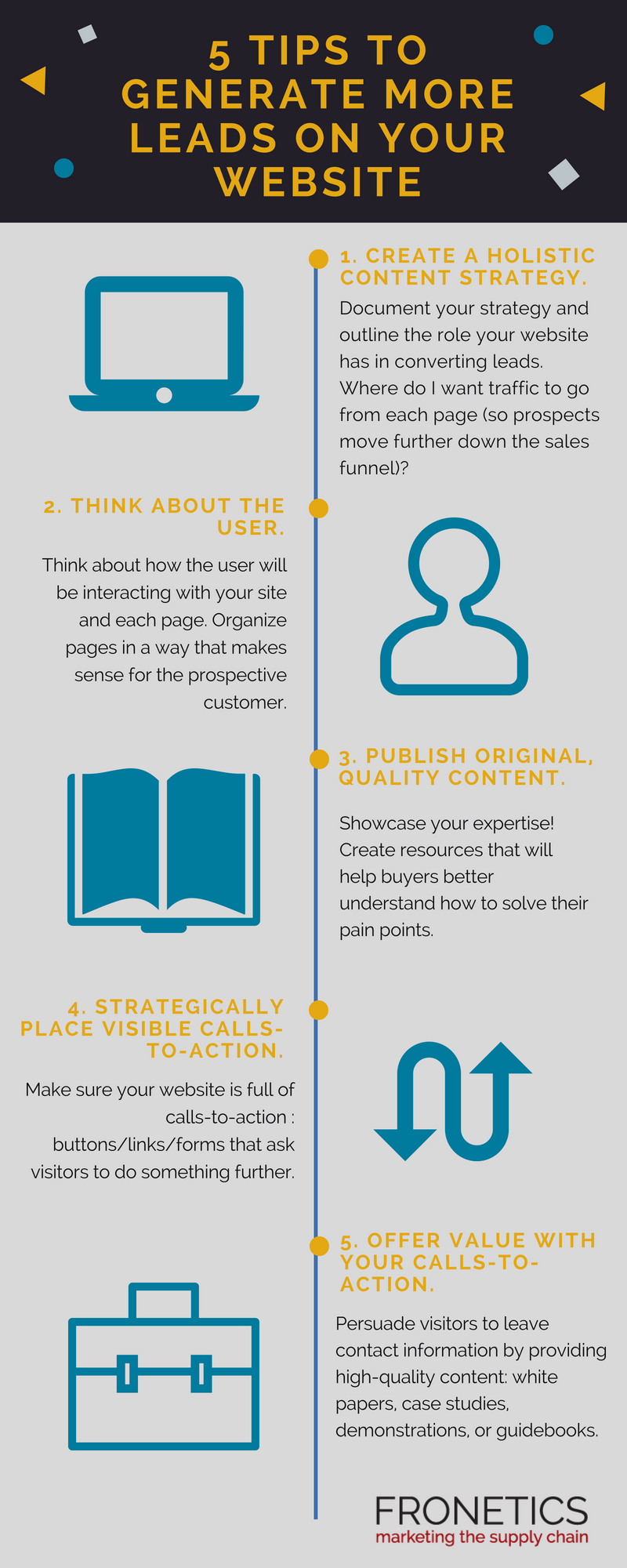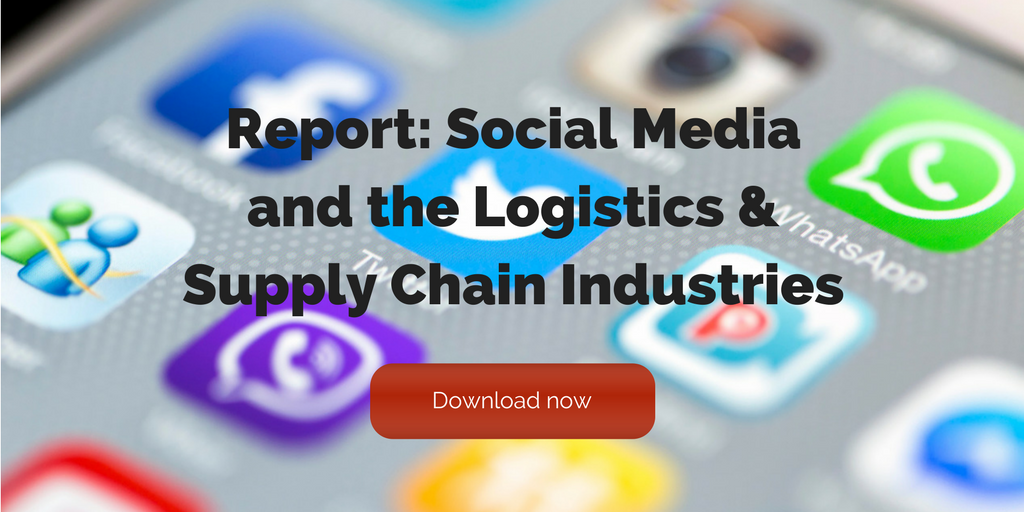
by Fronetics | Jun 21, 2018 | Blog, Content Marketing, Logistics, Marketing, Supply Chain
If you’re looking to generate more leads on your website, you need to create opportunities to capture visitors and implement a strong content strategy to encourage engagement.
Lots of supply chain and logistics companies are catching on to the benefits of content marketing. And of those, many are implementing a content marketing strategy to plan and execute their marketing.
[bctt tweet=”There’s no point in pouring a bunch of time, money, and resources into a robust content marketing program if the website that you’re driving traffic to stinks.” username=”Fronetics”]
But there’s an issue a lot of supply chain and logistics companies are running into: a weak website that doesn’t encourage the generation of leads. Essentially, there’s no point in pouring a bunch of time, money, and resources into a robust content marketing program if the website that you’re driving traffic to stinks.
In a recent post, we talk about what a weak website looks like. If you think you may fall into this category, don’t fret. There is still time to generate more leads on your website.
Consistently producing quality content and making sure you’re utilizing various distribution channels — social media, a blog, etc. — will help draw your target audience to your website. Once they’re on your site, you need to make sure they have a positive user experience. And more importantly, they need ample opportunities to learn more about your products and services.
These opportunities to engage with your content help move users down the sales funnel. You’ll capture leads that have the potential to become sales.
So how do you ensure your website is a lead-generating machine? Here are five tips to generate more leads on your website.
Infographic: 5 tips to generate more leads on your website

(Made with Canva)
Most importantly, remember to be prudent about the role your website plays in the lead-generation process. A strong website with quality content, great visuals, and easily identifiable calls-to-action only works to generate leads and push users down the sales funnel. You’ll still need someone to help close the deal.
Related posts:


by Elizabeth Hines | Jun 20, 2018 | Blog, Current Events, Leadership, Logistics, Strategy, Supply Chain
Artificial intelligence is forcing change on the supply chain in many ways. But robots, autonomous vehicles, and drones are just part of the equation. Does AI pose a threat to supply chain leadership as well?
A recent Harvard Business Review article explores the idea that “in an AI age characterized by intense disruption and rapid, ambiguous change, we need to rethink the essence of effective leadership. Certain qualities — such as deep domain expertise, decisiveness, authority, and short-term task focus — are losing their cachet, while others, such as humility, adaptability, vision, and constant engagement, are likely to play a key role in more-agile types of leadership.”
Can AI change supply chain leadership as we know it?
What is AI and why does it matter?
Artificial intelligence is coming to your business whether you’re ready for it or not (if it hasn’t already). Why does it matter? Because AI — the ability of machines to carry out tasks in a way we consider “smart” — can boost productivity and profitability.
What AI does “extraordinarily well,” according to consulting firm McKinsey & Co., “is relentlessly chew through any amount of data and every combination of variables.”
[bctt tweet=”Today we’re experiencing a second machine age as computers take on some of our mental workload by making data-driven decisions.” username=”Fronetics”]
Some technologists draw parallels to the Industrial Revolution when machines lightened the load for humans by performing tasks that once required brute strength. Today we’re experiencing a second machine age as computers take on some of our mental workload by making data-driven decisions.
The glass-half-empty crowd is worried that machines will replace humans and take our jobs. But the glass-half-full team sees new opportunities to unburden ourselves from repetitive tasks so we can focus on bigger strategic issues that need the nuanced emotional intelligence only we humans possess.
Traditional vs. AI-ready skills
“At some point in our evolution… leadership acumen transitioned from physical to cognitive skills, putting a premium on intelligence and expertise at the expense of force and strength,” writes HBR article authors Tomas Chamorro-Premuzic, Michael Wade, and Jennifer Jordan.
Offloading repetitive cognitive tasks to machines frees up time to develop new leadership skills. According to the authors, tomorrow’s leaders will be more empathetic, more agile, and more connected to people around them. The authors describe four specific qualities that will define leaders of the future:
Humility
Valuable intelligence won’t be delivered from the top down and may not come from the most experienced people on the team. It will come from every direction. Leaders should be open to suggestions and input from people using data at every level inside and outside the organization.
Adaptability
Changing your mind is a good thing in the age of AI. Learning organizations should expect to revise plans and iterate quickly. Managers should be confident enough to propose a change of course based on new data and not feel the need to defend their decision.
Vision
Operations can feel like shifting sands in an AI environment. An organization that continuously adapts to capitalize on new opportunities can leave employees feeling like they don’t know what they’re supposed to be doing from one day (or minute) to the next. Successful leaders will emphasize long-term goals, encourage questions, and provide clear, thoughtful, consistent answers.
Engagement
Successful leaders will come out of their executive suites and connect with customers, partners, and employees. You can’t wait for reports and meetings when fast-paced data-driven decisions are happening all around you. “Agile leaders need to stay engaged… and find ways to keep their teams engaged, particularly when the going gets rough and the path gets challenging,” according to Chamorro-Premuzic, Wade, and Jordan.
So will AI change supply chain leadership?
Learning and applying new skills won’t come easily for many businesses. Some managers might not be comfortable asking employees to demonstrate humility, adaptability, and vision. These are hard skills to measure and haven’t always been rewarded.
Real digital leadership will require a blend of human and machine learning and a new way of understanding how things get done. Any company stands to gain by adopting these new ideas.
Logistics companies, at the nexus of operations for so many industries, can lead the way into the AI age by modeling new skills and applying them to their own businesses.
Machine-learning expert Jeremy Howard sums it up nicely in a McKinsey & Company report: “There is no organization that shouldn’t be thinking about leveraging these approaches, because either you do — in which case you’ll probably surpass the competition — or somebody else will.”
What ways do you think AI will change supply chain leadership?
Related posts:


by Elizabeth Hines | Jun 19, 2018 | Blog, Content Marketing, Current Events, Logistics, Manufacturing & Distribution, Marketing, Supply Chain
Tesla has been long-favored to lead the charge in the mass adoption of EVs, but recent challenges have halted production. Can the Tesla become the next Honda Accord before they run out of money?
Plug-in electric passenger cars achieved a market share of only 1.16% of all car sales in 2017. That’s tiny. Some predicted 2018 might be the “year of the electric car,” but sales aren’t expected to break 2% this year.
[bctt tweet=”The auto industry is betting billions that electric vehicles will soon be as “cheap and ubiquitous as conventional cars.”” username=”Fronetics”]
Nearly all experts believe, however, that change is indeed coming. The auto industry is betting billions that electric vehicles (EVs) will soon be as “cheap and ubiquitous as conventional cars.” Some projections put electric vehicle sales over 20% by 2025. Others are more cautious and predict a slightly delayed rise to 25% by 2030. If the industry hits those numbers, it will be a boon to the electronics industry, as the number of cars with electronic components and the number of electronic components in each car grows by leaps and bounds.
Tesla has been long-favored to lead the charge in the mass adoption of EVs. But production of the company’s Model 3, the carmaker’s attempt at a mass-market sedan, has had major challenges, including issues with its supply chain. Can Tesla beat the ticking clock before the massive influx of money dries up?
Tesla’s ticking clock
Tesla is racing to overcome obstacles that have slowed the Model 3 progress, and the company’s make-or-break moment is fast approaching. The carmaker must boost production of the Model 3, or they will run out of money by the end of the year.
Since going public in 2010, Tesla has burned through an estimated $10 billion. Last year alone, Tesla spent more than $3.4 billion in cash — almost $1 billion a quarter — largely to bring production and sales of the Model 3 to sustainable levels.
Earlier this month, Tesla revealed that it nearly hit its target to manufacture 5,000 Model 3s a week, a production goal that is necessary to generating enough cash in house to sustain its own operations. Without it, the automaker will need to raise even more capital from outside investors.
Everyone expects that Tesla could, in fact, raise more funds if necessary. But proving it can build Model 3s at the thrice-promised target rate would go a long way in securing it.
The issues working against EVs
Even without its production issues, Tesla and other electric-vehicle manufacturers have their fair share of roadblocks.
The biggest issue to the supply chain? Electric-car battery manufacturing depends on the supply of certain minerals, including cobalt and lithium. As demand increases, these raw materials are increasingly scarce. Manufacturing is literally running into a metal crunch.
The biggest logistical issue? There are currently not enough places to re-charge.
Where exactly will we charge all those electric cars we plan on buying? Experts say that simply duplicating the existing refueling system, where motorists “charge up” like they “gas up” today would likely require dozens of new power plants or massive new investments in solar and wind farms.
The biggest issue to the American consumer? Battery-powered cars still cost more. Until that changes, consumers will still have a reason — a big reason — to go for more traditional gas-powered vehicles.
Could the Model 3 become the next Honda Accord?
So, even with all these current issues, could the Model 3 still be the highest-selling car of the next 40 years?
Tesla may still have a fighting chance if:
- they can solve their production issues;
- the battery market can find alternatives to its raw-materials shortage;
- the American public can feel confident that their batteries won’t die on the highway;
- the cost of EVs can rival that of traditional vehicles
Admittedly, that is a lot of “ifs,” but somehow no one is REALLY doubting that Tesla will pull it all off. But, not yet. A study last year found that 70% of millennials don’t yet want an electric car. Huh. Electric cars have mystique but simply don’t yet have widespread appeal.
Even taking these surprising stats into consideration, that still means 30% of young buyers consider an electric vehicle even now. So, by 2025 or 2030, when all the kinks are ironed out, they just may be as vanilla as Honda Accords. Except that the Model 3 is gorgeous, and electric, and made by Tesla. So maybe more like vanilla with rainbow sprinkles.
This post originally appeared on EBN Online.
Related posts:


by Fronetics | Jun 12, 2018 | Blog, Content Marketing, Leadership, Logistics, Marketing, Supply Chain
If you want to be a better delegator, you have to assemble a strong team and make sure they use you as a resource, among other things.
We’ve all heard it: the ability to delegate is critical to being an effective leader. And yet it’s one of the hardest leadership skills to master.
Giving over control isn’t easy, but effective delegation is crucial to keep your business running smoothly — and to keep you sane!
Here are our top 5 tips for supply chain leaders to become better delegators.
5 tips to be a better delegator
1) Choose your people.
This is about assembling a strong team you can trust. If you know you have smart, capable team members, you can be confident in the work they’ll perform for you, even if you’re not breathing down their necks.
2) Be clear.
[bctt tweet=”Setting up your team for success starts with clarity about your expectations. This means unambiguously communicating your goals for a project, as well as a timeline for benchmarks and completion. ” username=”Fronetics”]
Setting up your team for success starts with clarity about your expectations. This means unambiguously communicating your goals for a project, as well as a timeline for benchmarks and completion. Your expectations should be challenging, but reasonable. And it’s your responsibility to make sure they’re understood.
3) Be a resource.
It’s important that your team knows that once you’ve handed over a task, you’re still available for clarification and support. Make sure good communication patterns are in place, and that your team feels free to come to you with questions and issues.
4) Inspire results.
This one is about helping your team understand the bigger picture of why a project is important or worthwhile, and about leading without fear or blame. To be fully committed to a project, your team members need to understand how the work they’re putting in is contributing to a larger result.
5) Let go.
Repeat this ten times every night before you fall asleep: “Micromanagement is counterproductive.” Leaders like to be in control. But once you’ve delegated a task, clearly communicated your expectations, and set up open lines of communication, it’s time to step back and trust your people, as well as your own leadership abilities.
Bonus tip
Say thank you! Providing written, verbal, or public recognition for a job well done is an important element of inspiring your team to perform for you the next time they step up to the plate. And an important element of your being a better delegator.
What tips do you have for becoming a better delegator?
Related posts:


by Jennifer Hart Yim | Jun 4, 2018 | Blog, Content Marketing, Current Events, Logistics, Manufacturing & Distribution, Marketing, Supply Chain
3-D printing opens up new revenue opportunities for supply chain, helping companies meet demand in real time, manage inventory without limiting products they offer, and increase lead time.
This article is part of a series of articles written by MBA students and graduates from the University of New Hampshire Peter T. Paul College of Business and Economics.
Spring has finally arrived in New England. However, with spring comes every vehicle’s most dreaded enemy, the pothole! My coworker Will recently fell victim to one such nemesis. His part-sourcing saga has me wondering how soon the narrative may change.
On what started as a normal morning, Will soon found himself calling a tow truck to get his car to the shop and a coworker to get himself to work. An unavoidable pothole caused one of his ball joints to fail, and limping anywhere was not an option. The silver lining of the day was that his very accommodating mechanic agreed that Will could source his own parts.
A sourcing saga ensued.
The layers of research he had to do was frustrating. Which manufacturers make the quality of product he wants? Then which distributors can provide him the quantity he needs when he needs them at the best price?
This meant calls to local auto part stores, price checking against online distributors, verifying brands & model numbers, accounting for lead times, stockouts, shipping and handling fees to determine how to get the best total value of quality, cost, and delivery.
Complex decisions like this are common in many sourcing scenarios.
But does it have to be?
What if distributors could better manage their inventory without limiting the products that they offer or increasing the lead times to their customers?
With 3-D printing, that may soon be attainable.
Rather than holding inventory from various manufacturers, a distributor could have license agreements with manufacturers to print parts on demand.
Revolutionary though this sounds, it’s not an unfamiliar model. Not so long ago, buying music meant going to a physical store to purchase or order an album. Now streaming services have license agreements with record companies to meet consumer demand in real time.
Jay Leno has been 3-D printing parts for his fleet of classic cars for nearly a decade. He admitted that initially the costs were prohibitive for most people. However now that 3-D printers are available at a wide range of price points, it is becoming more economical to print products on demand.
Printing parts with low inventory turns on demand would reduce inventory costs within the entire supply chain, having a positive impact on a company’s bottom line. High-value, low-volume parts like those of late model vehicles are the perfect candidates. In fact, BMW, Porsche, and Mercedes-Benz Trucks have begun 3-D printing spare parts older models and freight trucks.
3-D printing and logistics
The next logical progression to reduce overall supply chain cost is to move production as close to the customer as possible. Logistics companies are positioning themselves to be ready to integrate into this production model.
Both UPS and DHL have recognized the potential for end-of runway 3-D print capabilities and local 3-D “print shops.” UPS has partnered with SAP and Fast Radius to launch its On-Demand 3D Printing Manufacturing Network, which leverages 3-D printing technology, analytics and UPS’s global network to execute production at the location where capacity and logistics are optimum.
This summer, BMW Motorrad will provide spare-part printing capability directly to customers with BMW Motorrad iParts, a mobile 3-D printer designed to travel with you on the back of your BMW Motorrad motorcycle. Customers will use a mobile app to download a part file from the cloud-based library and print parts on the go. Although limited by the size of the printer, Motorrad rides will be able to replace small parts in nearly any location. Customers can even preload files so, no matter where they are — the side of a mountain or the middle of a desert — they can make spare parts.
These companies are not alone in seeing the value of 3-D printing on the go. Amazon made headlines when it first filed for a patent on a 3-D printing delivery truck. That patent was granted at the beginning of this year. Although a launch plan has not been announced, a major player with that capability is a definite catalyst for more innovation at the intersection of 3-D printing and logistics.
The future
[bctt tweet=”It’s clear that logistics and inventory management will not look the same 10 years from now. The question is: when and where it will be economical to print parts on demand?” username=”Fronetics”]
It’s clear that change is coming, logistics and inventory management will not look the same 10 years from now. The question is: when and where it will be economical to print parts on demand? Will it be at an end-of-runway distribution center, a local multipurpose 3-D printing shop, or on-site at repair shops? Will AAA be able to print a new ball joint in a roadside truck and change it out like it was no different than the services they offer for tires and battery today? I can’t wait to find out.
In the meantime, Will had to deal with today’s sourcing options. After many phone calls, dozens of emails, and multiple carpools to work, his car is back on the road. And he believes he got four new ball joints at a good value.
About the author
Ruth DeMott is a quality engineer at Pratt & Whitney currently pursuing an MBA at the University of New Hampshire. She holds a BS in Industrial Engineering from Worcester Polytechnic Institute (class of 2010). She has held roles of increasing responsibility in the manufacturing and quality engineering departments since joining Pratt upon completion of her undergraduate degree. She is involved in the New Hampshire Youth Rugby program, enjoys traveling, putting things together, and spending time with friends and family.
Related posts:










